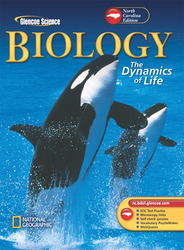 
Biology: The Dynamics of Life, North Carolina EditionChapter 33:
Animal BehaviorWeb Links
| Click the Techie Toolbox for tips and help to make the most of your time on the Web.
 <a onClick="window.open('/olcweb/cgi/pluginpop.cgi?it=gif::::/sites/dl/free/0078675642/181784/techietoolbox.gif','popWin', 'width=NaN,height=NaN,resizable,scrollbars');" href="#"><img valign="absmiddle" height="16" width="16" border="0" src="/olcweb/styles/shared/linkicons/image.gif"> (2.0K)</a> <a onClick="window.open('/olcweb/cgi/pluginpop.cgi?it=gif::::/sites/dl/free/0078675642/181784/techietoolbox.gif','popWin', 'width=NaN,height=NaN,resizable,scrollbars');" href="#"><img valign="absmiddle" height="16" width="16" border="0" src="/olcweb/styles/shared/linkicons/image.gif"> (2.0K)</a>
p. 858
 <a onClick="window.open('/olcweb/cgi/pluginpop.cgi?it=gif::::/sites/dl/free/0078675642/181784/biology_online.gif','popWin', 'width=NaN,height=NaN,resizable,scrollbars');" href="#"><img valign="absmiddle" height="16" width="16" border="0" src="/olcweb/styles/shared/linkicons/image.gif"> (1.0K)</a> <a onClick="window.open('/olcweb/cgi/pluginpop.cgi?it=gif::::/sites/dl/free/0078675642/181784/biology_online.gif','popWin', 'width=NaN,height=NaN,resizable,scrollbars');" href="#"><img valign="absmiddle" height="16" width="16" border="0" src="/olcweb/styles/shared/linkicons/image.gif"> (1.0K)</a>
| | Animal Behavior Society | | This is a site dedicated to promoting research in animal behavior. Choose at least three of the ABS news stories to read. Use the information to prepare a brief presentation for your class.
(
http://www.animalbehavior.org/
) |  |  |  | | CISAB - Kid's Page | | Visit this page to find out what the featured animals of the month are. Select one of the featured animals and construct a bulletin board display about that animal and its behaviors.
(
http://www.indiana.edu/~animal/kids.html
) |  |  |  | | How Biological Clocks Work | | The National Institutes of Health site on biological clocks has a wealth of information about circadian rhythms. When was the first circadian gene located? In what animal was it located?
(
http://www.nimh.nih.gov/publicat/bioclock.cfm
) |  |  |  | | Important Scientists in the Early Development of Comparative Cognition | | Find out about some of the early scientists that contributed to the study of animal behavior. Develop a timeline of these scientists and their contributions. Display the timeline in your classroom.
(
http://www.pigeon.psy.tufts.edu/psych26/history.htm
) |  |  |  |
p. 875
 <a onClick="window.open('/olcweb/cgi/pluginpop.cgi?it=gif::::/sites/dl/free/0078675642/181784/biolab.gif','popWin', 'width=NaN,height=NaN,resizable,scrollbars');" href="#"><img valign="absmiddle" height="16" width="16" border="0" src="/olcweb/styles/shared/linkicons/image.gif"> (1.0K)</a> <a onClick="window.open('/olcweb/cgi/pluginpop.cgi?it=gif::::/sites/dl/free/0078675642/181784/biolab.gif','popWin', 'width=NaN,height=NaN,resizable,scrollbars');" href="#"><img valign="absmiddle" height="16" width="16" border="0" src="/olcweb/styles/shared/linkicons/image.gif"> (1.0K)</a>
| | Snail Rearing | | Visit this site to learn what's necessary to raise snails. What food do they need? What types of environments are needed for breeding or hibernating?
(
http://home.nordnet.fr/~phthomas/snail.htm
) |  |  |  | | Land Snails | | Snails can be found in a variety of habitats. The largest group of snails are those that live on land. What adaptation do they have that enables them to live on land?
(
http://nighthawk.tricity.wsu.edu/museum/ArcherdShellCollection/Gastropoda/Pulmonates.html
) |  |  |  | | Comparative Animal Behavior | | This site provides an overview of many forms of behavior, when the behavior is used, and why. Social interactions are behaviors that affect more than one animal. Provide examples for each type of interaction covered in the chart at the bottom of the page. Compare your examples to those of your classmates.
(
http://clawww.lmu.edu/faculty/lswenson/AnimBehav351/351SiiterOutlineC9.htm
) |  |  |  |
p. 876
 <a onClick="window.open('/olcweb/cgi/pluginpop.cgi?it=gif::::/sites/dl/free/0078675642/181784/bio_technology.gif','popWin', 'width=NaN,height=NaN,resizable,scrollbars');" href="#"><img valign="absmiddle" height="16" width="16" border="0" src="/olcweb/styles/shared/linkicons/image.gif"> (2.0K)</a> <a onClick="window.open('/olcweb/cgi/pluginpop.cgi?it=gif::::/sites/dl/free/0078675642/181784/bio_technology.gif','popWin', 'width=NaN,height=NaN,resizable,scrollbars');" href="#"><img valign="absmiddle" height="16" width="16" border="0" src="/olcweb/styles/shared/linkicons/image.gif"> (2.0K)</a>
| | Behavior Patterns of Sea Turtles | | Sea turtle populations are in trouble. Visit this site to find out why sea turtle populations are declining. Why is it so difficult to study these animals?
(
http://www.cccturtle.org/behav.htm
) |  |  |  | | North American Species' Migration Routes | | This site is part of the National Wildlife Federation's "Keep the Wild Alive" Campaign. Click on the various locations on the map to read more details about sea turtle migration. How often do adult female sea turtle return to nesting grounds?
(
http://www.nwf.org/keepthewildalive/migration/turtlemigration.html
) |  |  |  |
p. 878
 <a onClick="window.open('/olcweb/cgi/pluginpop.cgi?it=gif::::/sites/dl/free/0078675642/181784/real_world_bio.gif','popWin', 'width=NaN,height=NaN,resizable,scrollbars');" href="#"><img valign="absmiddle" height="16" width="16" border="0" src="/olcweb/styles/shared/linkicons/image.gif"> (1.0K)</a> <a onClick="window.open('/olcweb/cgi/pluginpop.cgi?it=gif::::/sites/dl/free/0078675642/181784/real_world_bio.gif','popWin', 'width=NaN,height=NaN,resizable,scrollbars');" href="#"><img valign="absmiddle" height="16" width="16" border="0" src="/olcweb/styles/shared/linkicons/image.gif"> (1.0K)</a>
| | What the Buzz is all About | | Find out how bees are able to communicate to each other through dancing. Who was Karl von Frisch and why did he win a Nobel Prize? What kind of a dance do bees use if food is more than 100 yards from the hive?
(
http://www.fonz.org/zoogoer/zg1995/buzz.htm
) |  |  |  | | Dancing Under a Polarized Sky | | Visit this site to discover how bees use different dances to communicate different messages to the hive. How do bees communicate distance and direction to each other?
(
http://www.polarization.com/bees/bees.html
) |  |  |  |
 |  |
|







